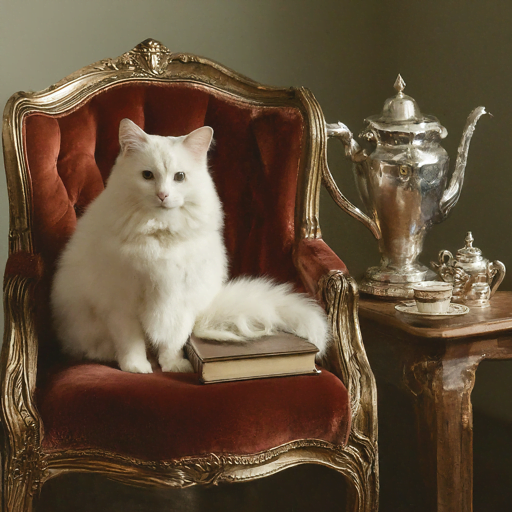The Victorians, a society steeped in tradition, etiquette, and a fascination with the natural world, held a unique place in their hearts for their feline companions. Cats, with their independent spirit, grace, and occasional moments of mischief, found themselves not just tolerated but embraced within Victorian households. But beyond offering a purring source of comfort and pest control, these discerning Victorians bestowed upon their cats names that reflected the spirit of the age.
This article delves into the fascinating world of Victorian Cat Names, exploring the cultural influences, literary inspirations, and social trends that shaped how these felines were addressed. We’ll uncover a treasure trove of monikers, from the dignified and classical to the whimsical and downright peculiar.

A Tailored Tendency: Cultural Influences on Victorian Cat Names
The Victorian Era, spanning from the 1830s to 1901, witnessed a period of immense social, cultural, and scientific change. These influences inevitably trickled down to the way Victorians named their cats. Here are some key aspects that shaped Victorian feline nomenclature:
- The Rise of the British Empire: Victorians reveled in their expanding empire, and cat names often reflected this. Names like Rajah (meaning “prince” in Hindi), Pasha (a title of high rank in the Ottoman Empire), and Cairo (referencing the Egyptian capital) were popular choices, imbued with a sense of exoticism and colonial power.
- The Classical Craze: Victorians were enamored with all things classical. Mythology, literature, and history provided a rich pool of inspiration for cat names. Characters from Greek and Roman myths like Diana (goddess of the hunt), Apollo (god of light and music), and Minerva (goddess of wisdom) graced feline forms. Literary giants like Shakespeare also lent their characters’ names – think Hamlet, Desdemona, or even the mischievous Puck.
- Science and the Natural World: The Victorian era saw a surge in scientific exploration and fascination with the natural world. This enthusiasm extended to cat names. Breeds like the newly established Siamese or Persian often inspired geographic monikers like Siam or Persia. Scientific discoveries also played a role, with names like Darwin (after the famed naturalist) or even Aurora (inspired by the newly understood auroras borealis) finding their way onto cat collars.
Beyond Breeds: A Look at Popular Victorian Cat Names
Victorian cat names transcended mere function. They were a statement of the owner’s taste, social status, and even a reflection of the cat’s personality. Let’s delve into some of the most popular Victorian cat names, categorized by style:
- Classic and Dignified: These names exuded an air of sophistication and refinement, befitting a Victorian household.
- Male:** Albert, Arthur, Bartholomew, Charles, Edward, Frederick, George, Henry, Jasper, Leopold, Oliver, Oscar, Reginald, Theodore
- Female: Agnes, Amelia, Beatrice, Catherine, Constance, Eleanor, Elizabeth, Emily, Evelyn, Georgina, Harriet, Isabella, Josephine, Lavinia, Penelope, Victoria
- Literary Inspirations:
Victorians were avid readers, and their literary heroes and heroines often found themselves immortalized in feline form.
- Male:** Basil (from “The Adventures of Sherlock Holmes”), Darcy (from “Pride and Prejudice”), Gatsby (from “The Great Gatsby”), Heathcliff (from “Wuthering Heights”)
- Female: Jane (from “Jane Eyre”), Juliet (from “Romeo and Juliet”), Scarlett (from “Gone With the Wind”), Titania (from “A Midsummer Night’s Dream”)
- Whimsical and Playful:
These names reflected the lighter side of Victorian life, often referencing a cat’s physical attributes or playful nature.
- Male:** Buttons, Mittens, Socks, Whiskers, Tiddles, Ginger, Marmalade, Patch, Jasper
- Female: Cuddles, Muffin, Pippin, Toffee, Poppy, Snowball, Willow, Whiskers
- Descriptive and Nicknames:
Victorians weren’t afraid to get creative, bestowing names based on a cat’s appearance or personality.
- Male:** Blackie, Shadow, Tiger, Tom (generic term for male cat), Rusty
- Female: Whiskers, Mittens, Tabby (referring to a striped coat pattern), Fluffy, Snowball
Victorian Cat Names by Category
| Category | Male Names | Female Names |
|---|---|---|
| Classic and Dignified | Albert, Arthur, Bartholomew, Charles, Edward, Frederick, George, Henry, Jasper, Leopold, Oliver, Oscar, Reginald, Theodore | Agnes, Amelia, Beatrice, Catherine, Constance, Eleanor, Elizabeth, Emily, Evelyn, Georgina, Harriet, Isabella, Josephine, Lavinia, Penelope, Victoria |
| Literary Inspirations | Basil (from “The Adventures of Sherlock Holmes”), Darcy (from “Pride and Prejudice”), Gatsby (from “The Great Gatsby”), Heathcliff (from “Wuthering Heights”) | Jane (from “Jane Eyre”), Juliet (from “Romeo and Juliet”), Scarlett (from “Gone With The Wind”), Titania (from “A Midsummer Night’s Dream”) |
| Whimsical and Playful | Buttons, Mittens, Socks, Whiskers, Tiddles, Ginger, Marmalade, Patch, Jasper | Cuddles, Muffin, Pippin, Toffee, Poppy, Snowball, Willow, Whiskers |
| Descriptive and Nicknames | Blackie, Shadow, Tiger, Tom (generic term for male cat), Rusty | Whiskers, Mittens, Tabby (referring to a striped coat pattern), Fluffy, Snowball |
| Mythological and Historical | Apollo, Hercules, Mars, Odin, Thor | Artemis, Diana, Hera, Minerva, Venus |
| Geographical | Cairo, Delhi, Persia, Siam |
Beyond the Moniker: A Glimpse into Victorian Cat Culture
While names offer a fascinating window into Victorian cat culture, there’s more to the story. Here are some additional aspects that paint a richer picture:
- The Rise of Cat Shows: The first-ever documented cat show was held in London in 1871. This event not only celebrated feline beauty but also served as a platform for showcasing unique and often extravagant cat names. Names like “The Mikado” (referencing a popular Gilbert and Sullivan operetta) or “Fitz-James” (a character from Sir Walter Scott’s novel “Rob Roy”) reflected the desire to stand out among the competition.
- The Working Cat: Not all Victorian cats were pampered lap warmers. Many were employed for a more practical purpose, namely, pest control. These working cats often had simpler, more utilitarian names like “Mouser” or “Ratty.”
- Gender and Class Considerations: There’s evidence that cat names might have reflected social class and gender roles in Victorian society. Upper-class Victorians tended to favor more classical or literary names, while working-class families might opt for simpler, more descriptive names. Additionally, female cats were more likely to receive whimsical or cutesy names compared to their male counterparts.
Feline Fancy and Fading Monikers: The Legacy of Victorian Cat Names
The Victorian era may be long gone, but its influence on cat names continues to resonate today. While some of the more esoteric choices (“Fitz-James” anyone?) have faded into obscurity, the love for classic and literary names remains strong. Names like Oliver, Luna, or even Jasper still grace countless cat collars, a testament to the enduring legacy of Victorian feline fancy.
Frequently Asked Questions (FAQs):
- What was the most popular cat name in Victorian England? It’s difficult to pinpoint a single most popular name. However, evidence suggests names like “Puss” (a generic term for a cat), descriptive names based on color or fur pattern (“Whiskers,” “Blackie”), and classic human names like “Tom” for males and “Tibby” for females were widely used.
- Did Victorians have special names for different cat breeds? While breed registries weren’t as established in the Victorian era as they are today, there’s evidence of using geographical references for newly recognized breeds like “Siamese” or “Persian.”
- Did Victorians care much about their cats? Absolutely! While not to the same extent of modern pet pampering, Victorians viewed cats as valued companions and integral members of the household. The rise of cat shows and the plethora of unique names they bestowed on their feline friends are testaments to this affection.
Conclusion
The Victorians, with their love for tradition, literature, and a dash of eccentricity, left an indelible mark on the world of cat names. From the dignified “Leopold” to the playful “Tiddles,” their choices offer a glimpse into Victorian society and their relationship with their feline companions. As we continue to name our cats today, the legacy of Victorian cat names lives on, reminding us of the enduring bond between humans and these captivating creatures.
You might also want to check out these articles for more ideas: cat names inspired by taylor swift






